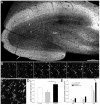Initial loss but later excess of GABAergic synapses with dentate granule cells in a rat model of temporal lobe epilepsy
- PMID: 20034063
- PMCID: PMC3098130
- DOI: 10.1002/cne.22235
Initial loss but later excess of GABAergic synapses with dentate granule cells in a rat model of temporal lobe epilepsy
Abstract
Many patients with temporal lobe epilepsy display neuron loss in the dentate gyrus. One potential epileptogenic mechanism is loss of GABAergic interneurons and inhibitory synapses with granule cells. Stereological techniques were used to estimate numbers of gephyrin-positive punctae in the dentate gyrus, which were reduced short-term (5 days after pilocarpine-induced status epilepticus) but later rebounded beyond controls in epileptic rats. Stereological techniques were used to estimate numbers of synapses in electron micrographs of serial sections processed for postembedding GABA-immunoreactivity. Adjacent sections were used to estimate numbers of granule cells and glutamic acid decarboxylase-positive neurons per dentate gyrus. GABAergic neurons were reduced to 70% of control levels short-term, where they remained in epileptic rats. Integrating synapse and cell counts yielded average numbers of GABAergic synapses per granule cell, which decreased short-term and rebounded in epileptic animals beyond control levels. Axo-shaft and axo-spinous GABAergic synapse numbers in the outer molecular layer changed most. These findings suggest interneuron loss initially reduces numbers of GABAergic synapses with granule cells, but later, synaptogenesis by surviving interneurons overshoots control levels. In contrast, the average number of excitatory synapses per granule cell decreased short-term but recovered only toward control levels, although in epileptic rats excitatory synapses in the inner molecular layer were larger than in controls. These findings reveal a relative excess of GABAergic synapses and suggest that reports of reduced functional inhibitory synaptic input to granule cells in epilepsy might be attributable not to fewer but instead to abundant but dysfunctional GABAergic synapses.
2009 Wiley-Liss, Inc.
Figures






Similar articles
-
Synaptic input to dentate granule cell basal dendrites in a rat model of temporal lobe epilepsy.J Comp Neurol. 2008 Jul 10;509(2):190-202. doi: 10.1002/cne.21745. J Comp Neurol. 2008. PMID: 18461605 Free PMC article.
-
Reduced inhibition of dentate granule cells in a model of temporal lobe epilepsy.J Neurosci. 2003 Mar 15;23(6):2440-52. doi: 10.1523/JNEUROSCI.23-06-02440.2003. J Neurosci. 2003. PMID: 12657704 Free PMC article.
-
Hyperexcitability, interneurons, and loss of GABAergic synapses in entorhinal cortex in a model of temporal lobe epilepsy.J Neurosci. 2006 Apr 26;26(17):4613-23. doi: 10.1523/JNEUROSCI.0064-06.2006. J Neurosci. 2006. PMID: 16641241 Free PMC article.
-
Neuroplasticity in the damaged dentate gyrus of the epileptic brain.Prog Brain Res. 2002;136:319-28. doi: 10.1016/s0079-6123(02)36027-8. Prog Brain Res. 2002. PMID: 12143392 Review.
-
Neuronal plasticity in animal models and the epileptic human hippocampus.Epilepsia. 2009 Dec;50 Suppl 12(Suppl 12):29-31. doi: 10.1111/j.1528-1167.2009.02365.x. Epilepsia. 2009. PMID: 19941518 Free PMC article. Review. No abstract available.
Cited by
-
GABAergic transmission facilitates ictogenesis and synchrony between CA3, hilus, and dentate gyrus in slices from epileptic rats.J Neurophysiol. 2013 Jul;110(2):441-55. doi: 10.1152/jn.00679.2012. Epub 2013 Apr 24. J Neurophysiol. 2013. PMID: 23615549 Free PMC article.
-
Induction of Temporal Lobe Epilepsy in Mice with Pilocarpine.Bio Protoc. 2020 Feb 20;10(4):e3533. doi: 10.21769/BioProtoc.3533. eCollection 2020 Feb 20. Bio Protoc. 2020. PMID: 33654757 Free PMC article.
-
Waking up the dormant dentate gyrus.Epilepsy Curr. 2013 Sep;13(5):224-5. doi: 10.5698/1535-7597-13.5.224. Epilepsy Curr. 2013. PMID: 24348113 Free PMC article. No abstract available.
-
Cellular plasticity induced by anti-α-amino-3-hydroxy-5-methyl-4-isoxazolepropionic acid (AMPA) receptor encephalitis antibodies.Ann Neurol. 2015 Mar;77(3):381-98. doi: 10.1002/ana.24293. Epub 2015 Jan 29. Ann Neurol. 2015. PMID: 25369168 Free PMC article.
-
Transient muscarinic and glutamatergic stimulation of neural stem cells triggers acute and persistent changes in differentiation.Neurobiol Dis. 2014 Oct;70:252-61. doi: 10.1016/j.nbd.2014.06.020. Epub 2014 Jul 6. Neurobiol Dis. 2014. PMID: 25003306 Free PMC article.
References
-
- André V, Marescaux C, Nehlig A, Fritschy JM. Alterations of hippocampal GABAergic system contribute to development of spontaneous recurrent seizures in the rat lithium-pilocarpine model of temporal lobe epilepsy. Hippocampus. 2001;11:452–468. - PubMed
-
- Andrioli A, Alonso-Nanclares L, Arellano JI, DeFelipe J. Quantitative analysis of parvalbumin-immunoreactive cells in the human epileptic hippocampus. Neuroscience. 2007;149:131–143. - PubMed
-
- Arellano JI, Muñoz A, Ballesteros-Yáñnez I, Sola RG, DeFelipe J. Histopathology and reorganization of chandelier cells in the human epileptic sclerotic hippocampus. Brain. 2004;127:45–64. - PubMed
-
- Austin JE, Buckmaster PS. Recurrent excitation of granule cells with basal dendrites and low interneuron density and inhibitory postsynaptic current frequency in the dentate gyrus of macaque monkeys. J Comp Neurol. 2004;476:205–218. - PubMed
Publication types
MeSH terms
Substances
Grants and funding
LinkOut - more resources
Full Text Sources

